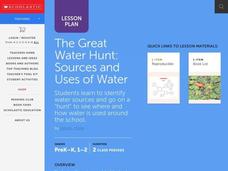Curated OER
Shimmering Waterfall
Learners study and identify waterfalls throughout the world. After exploring waterfall formations, they create 3-D waterfalls. Students create a cascading waterfall and a pond using cardboard and watercolors. They create additional...
Curated OER
Waterfalls
Third graders practice identifying the main idea and supporting details when reading informational text. They read text related to waterfalls and practice note taking skills to identify critical details. Students use their notes to...
Curated OER
World Wide Waterfalls
Young scholars explore the difference between virtual and actual experience by creating Web sites about a nearby river.
Curated OER
Dance: Water Dancing
Examine the way water moves, drips, and splashes with an expressive dance. Learners discuss the ways in which water moves, then create dance sequences that show or describe water. There are several suggestions to adapt this lesson plan...
Dick Blick Art Materials
Peace Windows
Peace, love, tolerance, faith. Marc Chagall's Peace Window in the United Nations World Headquarters serves as a model for young artists as they create their own peace-themed transparent paintings. A great activity for both SPED and...
Indian Land Tenure Foundation
Relationships to Places
Young historians take a look at how the Indian tribes of California promoted a mindful relationship between people and the land. They begin to understand how the Indians were champions of conservation, and at preserving the natural...
Polytechnic Institute of NYU
Potential vs. Kinetic Energy
Legos in science class? Watch your pupils fall in love with this activity. After learning to measure potential and kinetic energy, young scientists create their own ramps using Lego Mindstorm sensors and software.
Curated OER
The Great Water Hunt
Students create a model of the land to water ratio in a large group and search for all the places water is used at their school while on a Great Water Hunt. They identify where water can be found and compare how much of world is covered...
Curated OER
The Great Water Hunt
Students examine a globe to locate the bodies of water present and create a representation of those bodies of water for further exploration of the concept. Extensions of their observations are made at school, home, and the community.
Curated OER
Attitudes Towards Nature in Daoist Art
Students examine Daoist art. In this art appreciation activity, students illustrate a poem, then create a second illustration in the Daoist fashion while focusing on depicting the harmonious relationship between humans and nature.
Curated OER
Stressed to a Fault!
Eighth graders describe how stress builds up in the Earth's crust by the movement of tectonic plates. In groups, they relate the three types of stresses to the types of plate movements and explain how the stress causes faults to form. ...
Curated OER
Jambo Means Hello: An Introduction To Swahili
Students gain an appreciation for Swahili as a language spoken in many parts of Africa. They share and illustrate words from their own culture using English and Swahili and others to create a word quilt.
Curated OER
Fractals Forever or Obvious and Hidden Order
High schoolers discuss ways computers use properties of similar figures to generate scale models and create scenes. they describe patterns they have seen on a fern, pineapple, or pinecone. Students research Benoit mandebrot, H. von Koch...
Curated OER
Distortion Unleashed
Students view examples of man-made structures and create a building that matches the style. Using the internet, they research the style of Frank Lloyd Wright and create plans for creating their own community. They use a painting of...
Curated OER
Classroom Letter Bottle
Students study the alphabet. In this alphabet lesson, students use letters and natural objects to create an alphabet jar. Students can use this learning center to reinforce letter recognition.
Curated OER
Wonderful Water
Students identify the various states of water and its natural flow downward. As a class, students take digital pictures of different forms of water and create a multimedia presentation describing their photographs. Groups of students...
Foundation for Water & Energy Education
How is Flowing Water an Energy Source? Activity A
Here is a fun little exploration of the potential energy potential of falling water. Learners drop water from various heights using a straw, and they analyze the diameter of the splash. Pair this with two more activities of the same...
Curated OER
Rivers and Streams Research Activity
For this geography research worksheet, student examine books, newspapers, or the internet to find information about the history of flooding in the United Kingdom. They write a fictional account in a news report, TV interview, or a blog....
Curated OER
Geography of Mesopotamia
Students write a letter. For this irrigation lesson, students review how humans and the environment can interact with each other, learn new vocabulary words having to do with Mesopotamia, learn about irrigation and view maps of...
Curated OER
Being There: Exploring China And Japan
Students discover the culture, society, geography, and history of Asia through games, food, art, and literature in this multi-day instructional activity about China and Japan. An exciting instructional activity for upper-elementary or...
Curated OER
Exploring Landforms
Second graders discuss the different types of landforms throughout the world. They pick one and research and present it to the class.
Curated OER
Save That Water
Young scholars investigate water conservation. In this environmental lesson, students brainstorm ways they use water and discuss ways to conserve water. Young scholars illustrate and write about their method of water conservation.
Curated OER
Economic Crisis in Argentina
Students investigate the history, people, and the economy of Argentina. They complete a Webquest, explore various websites, answer discussion questions, and identify and read newspaper articles about local businesses that export goods to...
Curated OER
Dark and Beautiful Caves
Students research how caves form. They describe the major stone formations in caves by taking notes. They construct a clay model of a cave and mark each formation making it easy to identify in the legend.























